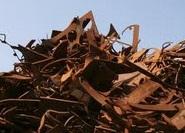Market

May 7, 2015
Scrap Prices Rangebound or Surprise to Come?
Written by John Packard
Perhaps the scrap market can best be described by those actively sourcing/selling ferrous scrap. Here is how one of the larger groups saw the market this week, “The scrap trade was quite tumultuous this week. Scrap demand, both export and domestic was robust, forcing the scrap processors to take a hard look at what sales to take or pass on. Regional disparities were much more significant than usual as scrap was dislocated from the Midwest into the “river” and Southeast markets. However, some of this pressure was relieved by availability and bookings of competitively priced imports of scrap and metallics. Overall, the market settled generally sideways to up slightly ($5-10/gt), primarily based on regional factors and April settlements…”
When referring to imports of metallics our source is referencing pig iron and DRI (direct reduced iron). We spoke directly with one of the pig iron sources for the domestic steel mills and we were told that recent deals to Nucor and SDI (Columbus) were done at $268-$268.50 out of Brazil.
Since pig iron is produced directly from iron ore it does not have the residual elements in it that are contained in scrap (especially the obsolete grades) making it a better product for EAF mills.
We also learned a vessel of low residual ferrous scrap was sold to one of the domestic steel mills out of Europe at $290 per metric ton delivered.
The market is being termed as “tumultuous” because a number of mills in the north attempted to take prices lower before being spurned by their suppliers. The Detroit area mills tried to push scrap prices lower by $10 to $15 per gross ton as May negotiations began but were met with strong resistance by their ferrous scrap suppliers. The end result was essentially a sideways market in Detroit.
The East Coast has been benefiting from the return of Turkish scrap buyers who are back buying U.S. ferrous scrap for export to Turkey. Our sources have advised SMU that the last sale of an 80/20 mix of obsolete grades of scrap (HMS) was $279 per metric ton and the current offers to sell have increased to $280-$285 per metric ton.
The return of the export market takes ferrous scrap that had been flooding the east and as far west as the Ohio Valley out of the market. This creates a floor for scrap prices in those markets that had been affected by exporters in prior months when there was little to no export business.
Prices in the east to the domestic steel mills were reported to have traded sideways (remained the same as last month) and in some instances were up $5 per ton.
An East Coast scrap dealer told us, “May ferrous trading ended up about how we thought it would – stronger in the south and east, and weaker as you work your way into the Midwest. The same themes we saw in April and even March trading were present again, with a continued lack of obsolete supply helping to firm up prices in the southeast. The two largest scrap buyers (DJJ and Omni) were content to buy as much scrap as they could going to their mills at sideways and even paid some slightly higher numbers. Shred in the southeast traded for anywhere from $275/GT to $285/GT. There might have even been a $290 number. In the northeast, prices were mainly sideways from April (shred at $260), though some of the Gerdau mills had to raise HMS prices slightly to between $240-50.
“But the real story was the strengthening export market. Turkish buyers have come back to the US to replenish low inventory levels and delivered prices for 80/20 HMS to Turkey now exceed $280/MT cif. The exporters are not awash in inventory so their dockside buying prices are rising now too.”
“It has been though to push prime grades higher but I expect that to get easier as we get into summer. The Midwest and OH Valley don’t show many signs of life but there are rumors that some mills that have not been consistent buyers of scrap over the last several months will begin to reenter the market slowly over the next several months (TPK Ipsko Koppel for one).”
The numbers in the Ohio Valley for the month of May delivery came in as follows:
Heavy Melt (HMS) = $235-$245 per gross ton
Shredded scrap = $265-$272 per gross ton
Busheling scrap = $255-$270 per gross ton
On the East Coast we heard the following:
Heavy Melt (HMS) = $245 per gross ton
Shredded scrap = $265 per gross ton
Busheling scrap = $255 per gross ton
Chicago / Northern Indiana area:
Heavy Melt (HMS) = $225-$230 per gross ton
Shredded scrap = $250-$263 per gross ton
Busheling scrap = $240-$245 per gross ton
In the South/Southeast (average) we heard the following numbers:
Heavy Melt (HMS) = $245-$255 per gross ton
Shredded scrap = $270-$280 per gross ton
Busheling scrap = $270-$285 per gross ton
We heard of one mill paying up on shred to the tune of $296 in the Alabama market.
Range Bound Scrap Market or, Surprise Upside to Come?
From one of the weaker regions, the Ohio Valley, we heard from one of the dealers selling to the mills, “Scrap market today- in general- is supply driven. There is very little supply currently as the lower prices have reduced collections. Any uptick in demand will have an immediate effect on scrap prices. I sense larger demand in June and a resulting increase in scrap prices.”
Our East Coast scrap source told us, “It has been though to push prime grades higher but I expect that to get easier as we get into summer. The Midwest and OH Valley don’t show many signs of life but there are rumors that some mills that have not been consistent buyers of scrap over the last several months will begin to reenter the market slowly over the next several months (TPK Ipsko Koppel for one).”
One of our scrap sources warned that even though the “tone” of the market is for range-bound prices there could be a surprise to the upside in the coming months as demand grows and supply tightens. Here is how they had put it to SMU earlier today:
“A rather cautious tone of a “range-bound” market has developed as domestic steel and scrap producers/processors respond to global supply/demand dynamics which appear balanced in the near term. There is some growing sentiment, however, that if the EAF flat producers continue to gain share against the idled BOFs, scrap demand will continue to firm and potentially move higher, especially on prime grades, as supply tightens heading into June/July industrial curtailments; changeovers, maintenance, etc.”
The post Scrap Prices Rangebound or Surprise to Come? appeared first on Steel Market Update.






